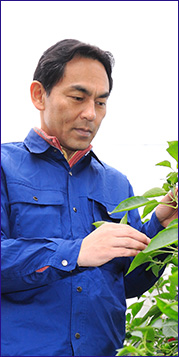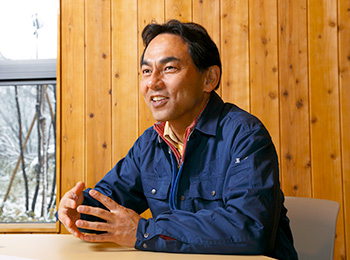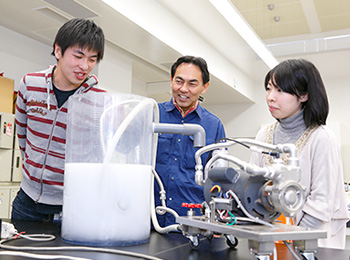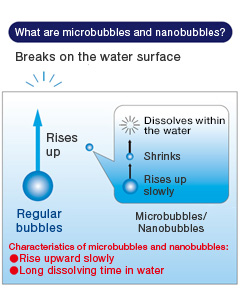

Exploring new-style, twenty-first-century agriculture
My research at the Agri Science Laboratory focuses on new types of agriculture for the 21st century as well as development of crop production systems. In recent years, I have been devoting my efforts toward research on the application of microbubbles and nanobubbles in the agricultural field to help accelerate crop growth and boost productivity.Microbubbles and nanobubbles are incredibly small bubbles measuring 50 μm (0.05 mm) or less in size—to understand just how small this is, one might note that the diameter of a human hair is approximately 70 μm.
Standard bubbles rise to the top of the liquid, burst upon reaching the surface and disappear; however, microbubbles and nanobubbles have very low volumes and buoyancies, enabling them to remain for long periods of time inside the liquid. Furthermore, these tiny bubbles dissolve readily, enabling more efficient utilization of oxygen and other such gases. Due to the unique properties that differentiate these bubbles from standard varieties, they have been receiving increasing attention lately throughout a wide variety of fields and are already being applied widely—for example, in wastewater treatment and cleaning of water supply pipes and industrial components in industrial operations, for oyster farming and cleaning before shipment in the marine products industry, etc.
Tiny bubbles hold vast potential

Engaging in activities centered on fascinating subjects such as cleaning soil contamination using flowers and agriculture for enjoyment and therapeutic purposes
Microbubbles and nanobubbles can be effortlessly dissolved in groundwater to supply oxygen and remedy this problem. This approach has already been put to use by some hydroponic famers, and it is proving to be an effective means of increasing profits.
Successful plant disease control is also a problem faced by many in hydroponics. If a pathogen enters the culture solution, this infectious agent can spread throughout the entire system and cause widespread damage to crops. Even in more enclosed, more germ-free plant factory environments, this danger cannot be completely eliminated. Because the use of agrochemicals in hydroponics is prohibited, culture tanks, hydroponic apparatuses, panels and beds used for planting seedings, and other such equipment must be sterilized each time using boiled water, chlorine-based materials, or other such means.

Collaborating with and providing data to microbubble and nanobubble generator equipment manufacturers to create equipment optimized for the agricultural industry
Harnessing the power of ozone to prevent disease
Much attention has been focused on ozone (O3) in response to the problems outlined above. Ozone’s bactericidal effect is so strong that is has been adopted for use sterilization in water supplies in the United States, Canada and Germany, and its use in culture fluids could provide an effective disease-prevention measure.Although ozone is difficult to dissolve into water in its normal state, the use of microbubbles and nanobubbles can make this process easier and enable the removal of unwanted bacteria in water. In addition, quick decomposition of ozone into oxygen (O2) is another attractive aspect of this approach, because which provides oxygen after disinfection, solving two problems at once.
The most significant problem that must be confronted is the management of ozone gas: it is dangerous to humans when present in high concentrations, requiring the use of extreme caution during ozone generator equipment operation, disposal of exhaust ozone gas and other such operations. In addition, ozone’s bactericidal power is reduced when it comes into contact with organic matter, which means that its effects are very good when used with newly planted seedings but decline when the plants’ roots expand and grow thicker. As a result, there is a need to increase stability throughout the period from planting to harvesting. However, because no pesticide residue remains as when using agrochemicals, ozone is considered to be ideal for disease prevention in plant factories and other enclosed environments.

Associate Professor Ikeda strives to dispel the image of agricultural work as a “3D” (dirty, dangerous and demanding) occupation and make it a production field that appeals to everyone
Recently, we have also been undertaking efforts based on the research theme of “agriculture for enjoyment and therapeutic purposes,” which began with a focus on the growth of plants in apartment complexes and similar urban environments as a form of interior decorating that creates a soothing, relaxing effect. While searching for aesthetically pleasing ways to shine lights on plants for display purposes, some students at the Laboratory informed me that Japanese mustard spinach (komatsuna) placed under LED lighting grew faster than usual. Although I had my doubts about this phenomenon at first, it became clear that that edible portions of these plants had somehow grown bigger than those of other plants; we are currently conducting research to discover the cause. We had previously thought that directing light at the roots hindered their growth—discoveries such as these, which force us to rethink our perceptions, are what make the research process so fascinating.
Entering a new age in agriculture
One of our main goals is to make agriculture more appealing to the younger generations, and our findings may help change the perception that many young people have—that of hard labor outside in the dirt and mud. In addition, by applying industrial technologies and increasing safety and reliability to achieve agricultural production with higher added value, we can create additional opportunities for corporations and individuals to enter the agricultural field while also providing successors for the industry, who are in very short supply.IT is becoming increasingly integrated into the field of greenhouse cultivation, enabling monitoring of greenhouse temperatures and growing conditions as well as execution of various operations from remote locations. Accumulation of knowledge, introduction of technologies and increases in productivity make it possible to achieve a profitable agricultural business. Collaboration between agriculture, commerce and industry has opened up a wide range of possibilities in terms of technological development.
Profile
Professor, School of Agriculture (Kurokawa Farm)Masahiko Tamaki served as a professor in the Prefectural University of Hiroshima’s Faculty of Life and Environmental Sciences before becoming a professor at Meiji University in 2006. He is the director of the Meiji University Kurokawa Farm, and he has a Ph.D. in agriculture from Nagoya University.
Fields of Research: Integration of agriculture and industry, crop growing methods utilizing microbubble and nanobubble technology, use of plants for environmental conservation, agriculture for enjoyment and therapeutic purposes
Publications, Academic Writing, Media Appearances, etc.: Maikurobaburu no Nogyo-bun’ya eno Riyo no Kanosei (“Possibilty of use of microbubble to agriculture: sterilization of hydroponics solution using ozone microbubble” Materials Integration), Bisai Kiho no Saishin Gijutsu (“The Latest in Microbubble Technology,” joint authorship, NTS), Maikurobaburu Nanobaburu no Saishin Gijutsu (“The Latest Technology on Microbubbles and Nanobubbles” joint authorship, CMC Publishing), Odoroki no Arashi! Seiki no Jikken—Gakusha mo Yosoku-fukano SP TV appearance (Nippon Television Network), Yume no Tobira TV appearance (Tokyo Broadcasting System Television), Arashi no Shukudai-kun TV appearance (Nippon Television Network), Ryori no Kaijin TV appearance (TV Tokyo), others









